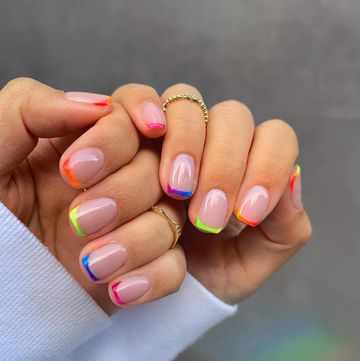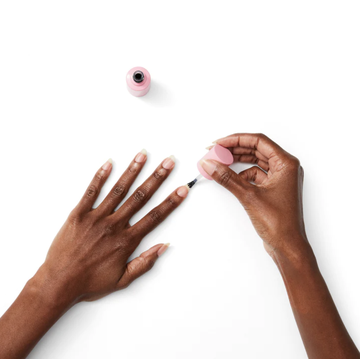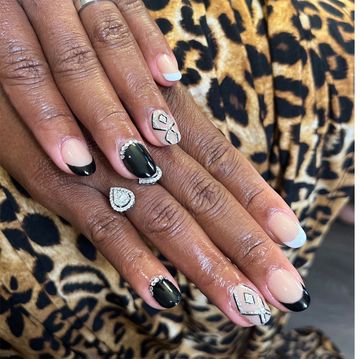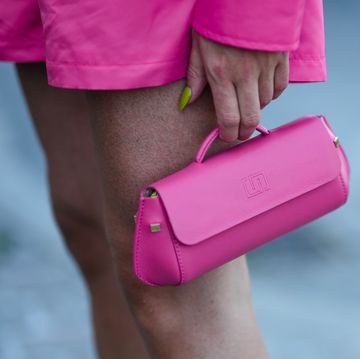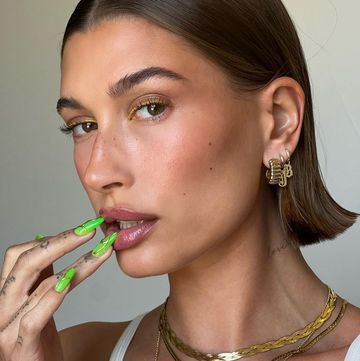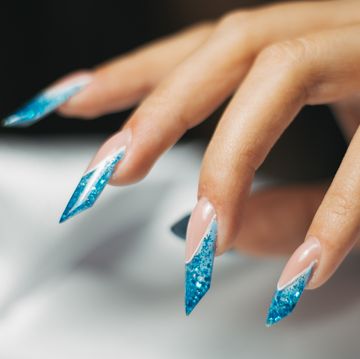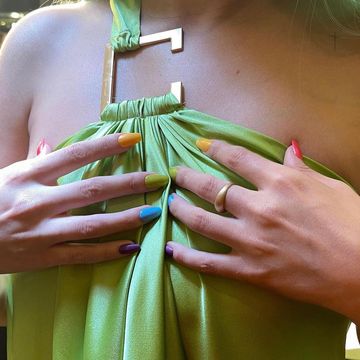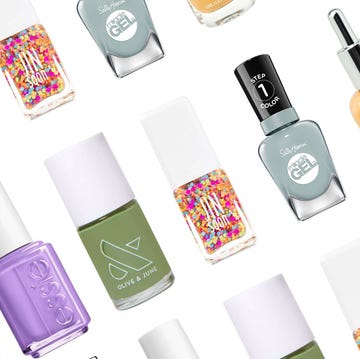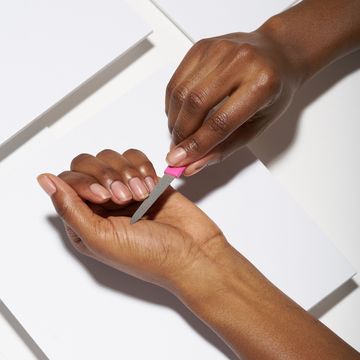Those long, seemingly unbreakable nails that celebs always have? They're most likely gel extensions. Somewhat similar to acrylic nails, gels are a great way to fake your way to longer, stronger nails (plus, they give you tons of surface area for nail designs). Like a regular gel manicure, gel extensions are cured onto the nail using UV light, but that’s about where the similarities end. To find out more about these popular sets, we asked Queenie Nguyen, celebrity manicurist, and Brittney Boyce, gel extension specialist and founder of Nails of LA, to share all their expert insights.
What Are Gel Extensions?
Gel extensions, quite simply, are used to lengthen the nails. What makes them different from acrylics is how they are applied, using what’s called a builder gel. “It's an oligomer, meaning the monomer and polymer are already mixed, and to adhere to your nail, it needs to be ‘cured’ with an LED or UV lamp,” explains Boyce, who likes Orly’s Builder in a Bottle. “Instead of mixing products, it's in a bottle that's easy to apply and is self-leveling, meaning the technician won't have to file the top to shape it well, and it's not sticky or messy.”
You’ll often see gel extensions used in nail art because the technique creates a clear base. “Gel extensions are great for all different types of nail art, including 3D nail art and the trending jelly-french tip look,” explains Boyce.
What Are the Benefits of Gel Extensions?
According to the pros, there are several things that make gel extensions superior:
- They’re versatile. “Builder in a Bottle from Orly comes in a clear shade, which is great for glass French tips, or a concealer shade, which mimics the color of nails with a milky neutral color,” says Boyce. “It's great for negative space nail art or for anyone looking for a more natural nail look.”
- They cause less damage to nails. “They are less damaging to the nail bed,” explains Nguyen, who adds that “They are easy to shape and do not require a lot of intense drilling.”
- They’re easier to remove. “You're also able to remove them by soaking them off, so it's less damaging to your nail,” explains Boyce.
- They don’t have an odor. Acrylics have a strong odor, which can be irritating to nail technicians. With gels, however, “There also isn't an odor which as a nail artist, I prefer,” says Boyce.
What Is the Process of Getting Gel Extensions?
“The process of getting gel extensions starts off similar to getting regular gel polish,” says Boyce. “The nail technician will prep by pushing back cuticles and removing any hangnails, shaping the nails, drying them with acetone or rubbing alcohol, then applying a primer to improve adhesion.”
Then, there are two ways you might have the extensions applied. “Some nail technicians will use the Perfect Fit Form, which fits under the nail for them to sculpt the tips onto the free edge of your nail by applying Builder on top of it,” explains Boyce. The other way involves "Fast Forms," which are formed off of the hand, then adhered to the nail. “They apply Builder on the forms that look almost like press-on nails, press it down onto the nail, cure it, then remove the forms," she says.
If you just want longer, stronger nails, you might want to consider the Builder gel. “Builder gel is great for those that prefer to just extend the length of their natural nails,” says Nguyen, who says the process takes longer “because the nail artist extends each nail at a time and then shapes all the extensions afterwards before polishing.”
After the extensions are finished curing, “the technician will file, shape, and buff the nails, apply any nail art, then finish with the topcoat,” says Boyce, who adds that “Some topcoats require a cleanse to remove any stickiness, while others don’t.’
Overall, expect the process to take one to two hours, depending on whether you choose nail art or not.
Who Can Get Gel Extensions?
Nearly anyone. “As long as your natural nail beds are healthy, you can get gel extensions,” says Boyce. But there are exceptions. If your nail beds are infected or very thin, you may want to hold off. It’s also helpful to have some length before getting extensions. “I would not recommend gel extensions for beginners who have extremely bitten nails or super short nails because you do need some nail bed to hold the extensions or they have no support and fall off quickly,” explains Nguyen.
How Long Do Gel Extensions Last?
“They can last anywhere from two to four weeks, depending on the skill of the nail technician as well as how naturally oily your nails are,” says Boyce. “People who tend to have oilier nails tend to see lifting a bit sooner."
How Much do Gel Extensions Cost?
It depends on your location, the salon you go to, and your nail tech. But expect to pay anywhere from $80-$200. Of course, the more intricate your look, the pricier the final cost will be as well.
How Are Gel Extensions Removed?
Gel extensions are removed by soaking off in acetone, although it’s recommended to have gel extensions professionally removed. “Some people do file the top off very slightly so it’s easier to soak off. Otherwise, it’s removed the same way you remove regular gel manicures,” explains Boyce.
And although gels are gentler on nails, a little post-removal TLC still helps. “Additionally, don’t forget to condition your cuticles post gel removal with cuticle oil to help nourish and soothe the nail beds and cuticles,” says Nguyen, who recommends Mineral Fusion’s vegan cuticle oil.
What’s the Difference Between Gel Extensions and Acrylics?
Gel extensions are generally considered the healthier alternative to acrylics—both for you and your nail technician. “Gel extensions are lightweight and look more natural than acrylic nails,” says Nguyen. And in addition to being less damaging to the nail bed, “They are easy to apply and have no intense smell like acrylics,” she says.
There’s also a different application process. Acrylics are “typically applied by mixing a polymer (powder) and a monomer (liquid) to create that dough-like consistency that nail technicians then mold into shapes and file down to thin it out,” explains Boyce.
Meet the Experts
Queenie Nguyen is a celebrity manicurist and brand ambassador for Mineral Fusion.
Brittney Boyce is a gel extension specialist and founder of Nails of LA.
Why Trust Harper's BAZAAR?
For more than 150 years, Harper’s BAZAAR has been the preeminent fashion and beauty resource for women at every age. We cover what’s new and what’s next in beauty by working with the world’s leading authorities in dermatology, plastic surgery, cosmetics, skincare, haircare, and fragrance. Every story we publish has been thoroughly researched and vetted by our team of beauty editors and industry experts.

Lindy Segal is a beauty writer and editor. In addition to regularly contributing to BAZAAR.COM, she also writes for Glamour, People, WhoWhatWear, and Fashionista, among other publications. She lives in New York City with her Chihuahua mix, Barney.



